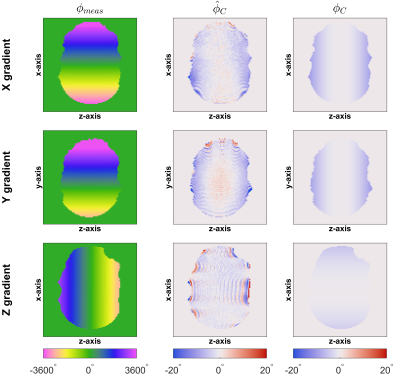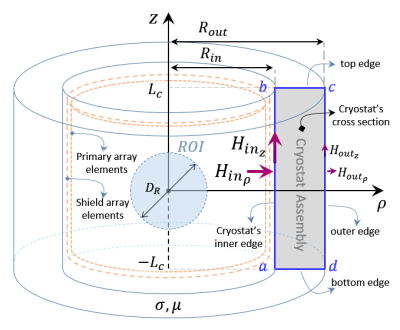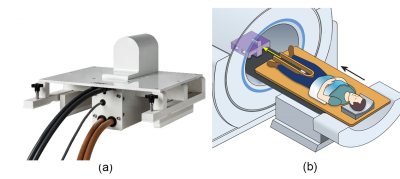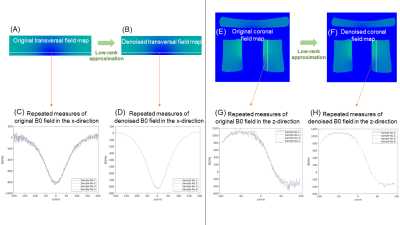Digital Poster
System Performance & Imperfections II
ISMRM & ISMRT Annual Meeting & Exhibition • 03-08 June 2023 • Toronto, ON, Canada

| Computer # | |||
|---|---|---|---|
4562. |
141 |
RF pulse optimization for robust excitation in 31P magnetization
transfer spectroscopy
Christina Graf1,
Clemens Diwoky2,
Armin Rund3,
and Rudolf Stollberger1
1Institute of Biomedical Imaging, Graz University of Technology, Graz, Austria, 2Institute of Molecular Biosciences, Karl-Franzens University Graz, Graz, Austria, 3Institute for Mathematics and Scientific Computing, Karl-Franzens University Graz, Graz, Austria Keywords: RF Pulse Design & Fields, RF Pulse Design & Fields In this work, robust excitation pulses for 31P spectroscopy at 7T are designed by optimal control. The particular challenges of inhomogeneous RF field due to use of surface RF coils and broad bandwidth requirements due to the nature of 31P were addressed thoroughly. The optimized RF pulses show superior performance compared to adiabatic RF pulses during numerical simulations and phantom experiments. Application of the optimized RF pulses to T1 prediction by dual angle method is the logical consequence. |
|
4563. |
142 |
RF Pulse Predistortion for Low-Field MRI Based on Spin Physics
Using a Neural Network Amplifier-to-Bloch Equation Model
Madison M Albert1,
Christopher E Vaughn1,
Jonathan B Martin1,
Sai Abitha Srinivas1,
and William A Grissom1
1Biomedical Engineering, Vanderbilt University, Nashville, TN, United States Keywords: RF Pulse Design & Fields, Low-Field MRI, Amplifiers, Predisortion In low-field MR, low-cost amplifiers with reduced fidelity are used. Current solutions to this problem require additional hardware and do not optimize the pulse for the final excitation profile. The proposed methodology models the amplifier with a neural network, connects the network to a Bloch simulator, and optimizes the pulses for the desired excitation profile. In simulation, a windowed sinc pulse (time-bandwidth product = 10, phase = 0 radians, duration = 1 ms) was optimized to minimize the loss between the target profile and the generated profile after the pulse passes through the amplifier to 0.05% of the starting loss. |
|
4564. |
143 |
Simultaneous Saturation and Excitation (SatEx) pulse
Shota Hodono1,
Chia-yin Wu1,2,3,
Carl Dixon1,
Donald Maillet1,
Jin Jin4,
Jonathan R Polimeni5,6,
and Martijn A Cloos1
1Centre for Advanced Imaging, The University of Queensland, St. Lucia, Australia, 2ARC Training Centre for Innovation in Biomedical Imaging Technology, The University of Queensland, St. Lucia, Australia, 3chool of Information Technology and Electrical Engineering, The University of Queensland, St. Lucia, Australia, 4Siemens Healthcare Pty Ltd, Brisbane, Australia, 5Athinoula A. Martinos Center for Biomedical Imaging, Massachusetts General Hospital, Charlestown, MA, United States, 6Division of Health Sciences and Technology, Massachusetts Institute of Technology, Cambridge, MA, United States Keywords: RF Pulse Design & Fields, Velocity & Flow We propose a new slice-selective excitation pulse that simultaneously saturates magnetization adjacent to it. The Saturation and Excitation (SatEx) pulse is a summation of two asymmetric sinc pulses whose leading lobes have been cut combined with an asymmetric excitation pulse with its final lobes truncated. The saturation and excitation slice profile were validated in simulations and a flow-phantom scan. The flow-phantom scan showed strong saturation of inflow effects. Since the SatEx pulse is as short as a conventional sinc excitation pulse, it can be implemented in a wide range of fast imaging sequences to suppress inflow effects without lengthening TR. |
|
4565. |
144 |
Design and Optimization of a MultiPINS Prepulse for
Two-dimensional Ultrashort Echo Time Simultaneous Multi-slice
Pulse Sequences
Jason A Reich1,
Erin MacMillan2,3,4,
and Rebecca Feldman1,5
1Computer Science, Mathematics, Physics and Statistics, University of British Columbia, Kelowna, BC, Canada, 2UBC MRI Research Centre, Department of Radiology, Faculty of Medicine, University of British Columbia, Vancouver, BC, Canada, 3SFU ImageTech Lab, Simon Fraser University, Surrey, BC, Canada, 4Philips Canada, Mississauga, ON, Canada, 5Biomedical Engineering and Imaging Institute, Icahn School of Medicine at Mount Sinai, New York, NY, United States Keywords: RF Pulse Design & Fields, RF Pulse Design & Fields It has been challenging to achieve ultrashort echo times with two-dimensional acquisitions. However, the use of a prepulse and a whole volume hard excitation may address these limitations. In addition, such a pulse sequence would allow for the use of simultaneous multi-slice pulses to reduce scan times. We aim to design a low specific absorption rate, short duration MultiPINS prepulse that excites a slice profile with sharp, narrow slice gaps. Optimization suggests that a pulse with time bandwidth product (TBW) of 49.43 is optimal, but further investigation suggests that a pulse with TBW as low as 36 may be feasible. |
|
4566. |
145 |
Analytical expression for gradient eddy current-induced power
dissipation in a thin conductive shell: A model for RF shield
heating
Seung-Kyun Lee1,
Matthew Tarasek1,
Yihe Hua1,
Keith Park1,
Daehun Kang2,
Matt A Bernstein2,
and Thomas Foo1
1GE Global Research, Niskayuna, NY, United States, 2Mayo Clinic, Rochester, MN, United States Keywords: Gradients, Gradients, eddy current Gradient-induced eddy current in an RF shield can cause significant temperature increase in the patient bore. As gradient coils produce higher amplitudes with faster rise time, understanding and controlling eddy-current heating become more and more important for patient safety and device longevity. Through time-domain analysis, we have derived a mathematical formula that relates the eddy-current heating of a uniform conductive shell to the properties of the conductor and the mean-square slew rate of the gradient waveform. The theoretical prediction was tested by experiments performed on a high-performance head-only gradient (MAGNUS) system. |
|
4567. |
146 |
Subject Specific Prediction of Gradient-Induced E-fields Using a
Multivariate Linear Modeling Approach
Koray Ertan1,
Peter B Roemer2,
and Brian Rutt1
1Radiology, Stanford University, Stanford, CA, United States, 2Roemer Consulting, Lutz, FL, United States Keywords: Gradients, Gradients, PNS, Peripheral Nerve Stimulation, Safety, Bioeffects, Magnetic Fields Peripheral Nerve Stimulation (PNS) remains as a limiting factor for gradient coils despite the recent advances. PNS thresholds varies significantly across population group. In this study, E-fields are simulated on simplified body model population with randomized realistic body dimensions and different patient landmark positions. It is shown that multivariate linear model with body dimensions and z-offset location as the independent variables can accurately predict the maximum E-field on the surface which can also be used to predict PNS thresholds. This simple multivariate model may pave the way to estimate subject specific PNS thresholds using simple anatomical measurements. |
|
4568. |
147 |
Modelling the gradient system as linear and time-invariant: Do
the assumptions break down at higher field strength?
Stefan Sommer1,2,3,
Herbert Köstler4,
and Hannah Scholten4
1Siemens Healthineers International AG, Zurich, Switzerland, 2Swiss Center for Musculoskeletal Imaging (SCMI), Balgrist Campus, Zurich, Switzerland, 3Advanced Clinical Imaging Technology (ACIT), Siemens Healthineers International AG, Lausanne, Switzerland, 4Department of Diagnostic and Interventional Radiology, University Hospital Würzburg, Würzburg, Germany Keywords: System Imperfections: Measurement & Correction, Gradients, GIRF, GSTF The gradient system transfer function (GSTF) is a broadly used model to characterize the gradient chain and correct for imperfections e.g. in non-Cartestian sampling trajectories. The model assumes linearity and time-invariance (LTI) of the system. In this work, we indirectly examine the LTI compliance across two different field strengths by comparing different GSTFs based on varying subsets of input gradient shapes for the model computation. Overall, only small changes in the GSTF were observed upon adding different input gradients for the system characterization. However, the differences were more pronounced at 7T compared to 3T. |
|
4569. |
148 |
Vector concomitant field mapping by phase contrast imaging
Seung-Kyun Lee1 and
Afis Ajala1
1GE Global Research, Niskayuna, NY, United States Keywords: Gradients, Gradients, concomitant field We show that concomitant field-induced phase in phase-contrast imaging allows measurement of the transverse (x,y) components of the magnetic field generated by a gradient coil. Combined with conventional B0 mapping which gives the z-component, the method permits experimental determination of the full three-dimensional vector magnetic field of a gradient coil. We demonstrate the method on a high-performance head gradient (MAGNUS) system and discuss its application to concomitant-field artifact correction based on one-time calibration. |
|
4570. |
149 |
Characterizing gradient performance and estimating Maxwell
fields at 0.55T.
Daniel West1,
David Leitão1,
Raphael Tomi-Tricot1,2,
Tobias C Wood3,
Jo Hajnal1,4,
and Shaihan Malik1,4
1Biomedical Engineering, King's College London, London, United Kingdom, 2MR Research Collaborations, Siemens, Frimley, United Kingdom, 3Department of Neuroimaging, King's College London, London, United Kingdom, 4Centre for the Developing Brain, King's College London, London, United Kingdom Keywords: System Imperfections: Measurement & Correction, Gradients In this work we use a general sequence to characterize gradient imperfections at low field (0.55T) by measuring the gradient impulse response function (GIRF). Maxwell fields become non-negligible at lower field strengths and so we incorporate these into our GIRF calculation to form a single processing pipeline. Once the predictive ability of the GIRF was confirmed, we use our data to estimate the Maxwell phase and compare this to an analytic approach; good agreement is observed. These results will inform future low-field investigations and enable an improved image quality for sequences that are particularly prone to gradient imperfections. |
|
4571. |
150 |
MRI Simulations for Complex 3D Flow using the Lattice Boltzmann
Method
Ansgar Adler1,
Nick Scholand1,
Jost Kollmeier2,
Yong Wang3,4,
and Martin Uecker1,4,5
1Insitute of Biomedical Imaging, Graz University of Technology, Graz, Austria, 2Biomedical NMR, Max Planck Institute for Multidisciplinary Sciences, Göttingen, Germany, 3Department of Fluid Physics, Pattern Formation, and Biocomplexity, Max Planck Institute for Dynamics and Self-Organization, Göttingen, Germany, 4DZHK (German Centre for Cardiovascular Research), Partner Site Göttingen, Göttingen, Germany, 5Institute of Diagnostic and Interventional Radiologie, Göttingen, Germany Keywords: Phantoms, Velocity & Flow, Simulation The lattice Boltzmann method (LBM) is a versatile technique to simulate fluid dynamics in complex environments. We extended the LBM to flows with a spin 1/2 degree of freedom in external magnetic fields. We performed 3D simulations for FLASH MRI of a laminar flow in a pipe and the complex flow of the Karman vortex street. |
|
4572. |
151 |
Thermal Model in Feedforward Control of the Gradient Array
System in MRI
Ege Aydın1,2,
Reza Babaloo1,2,
and Ergin Atalar1,2
1Department of Electrical and Electronics Engineering, Bilkent University, Ankara, Turkey, 2National Magnetic Resonance Research Center (UMRAM), Bilkent University, Ankara, Turkey Keywords: Gradients, System Imperfections: Measurement & Correction Resistive elements in a gradient system, namely the gradient coil and the amplifier, causes heating and the total system resistance to increase. With feedforward controllers, such changes cause inaccurate gradient fields to occur, which in turn causes image artifacts. To mitigate self-heating caused resistance change issues, modeling the gradient system's thermal behavior is necessary. Such a model introduces additional parameters to the overall feedforward model, and identifying these parameters correctly is essential for accurate current waveforms. For this purpose, we propose a method to extract these parameters along with a more complete thermal model. |
|
4573. |
152 |
A Novel Method to Estimate and Control the Eddy Power Loss
within the Cryostat: A Co-Simulation Approach to Tune Z-Gradient
Array Coil
Manouchehr Takrimi1 and
Ergin Atalar1,2
1UMRAM, Bilkent University, Ankara, Turkey, 2Electrical and Electronics Engineering, Bilkent University, Ankara, Turkey Keywords: Gradients, Hybrid & Novel Systems Technology, Gradient Array Coils We propose a fast computational method based on a series of electromagnetic simulations to calculate a proper set of feeding currents for a z-gradient array coil that dynamically provides the best shield for its primary array coil. The net magnetic field generated by each array element is calculated, and the total average eddy power (energy) loss resulting from fast-switching stray fields inside the cryostat assembly is estimated and controlled. Two design scenarios with comparable performance criteria are offered for a 48-element z-gradient array coil. The accuracy of the estimated eddy power losses is compared with that of commercial software. |
|
4574. |
153 |
The effects of RF channel numbers on |B1+| mapping using the BSS
method
Yinhao Ren1,
Yunyu Gao2,
Bensheng Qiu3,
Xiang Nan4,
and Jijun Han1
1School of Biomedical Engineering, Anhui Medical University, Hefei, China, 2School of Biomedical Engineering, Southern Medical University, Guangzhou, China, 3Center for Biomedical Imaging, University of Science and Technology of China, Hefei, China, 4Department of Anatomy, Anhui Medical University, Hefei, China Keywords: RF Pulse Design & Fields, Brain In the BSS method, WA and MLE as two methods in channel combination were proposed in |B1+| mapping for the multi-channel coils. We investigated the effects of the channel numbers on the performance of WA and MLE. The results showed the accuracy of |B1+| maps improved with the channel numbers increasing, even at low SNR. However, this trend slowed down when the channel numbers reached 24 or above. The RSD of WA and MLE was reduced to 6.6% and 4.0% for 24-channel coils, but the improvements were only 1.0% and 0.7% for 32-channel coils at SNR=25. |
|
4575. |
154 |
Diffusion Weighted Imaging using a Prostate Nonlinear Gradient
Coil
Nahla M H Elsaid1,
Terence Nixon1,
Andrew Dewdney2,
Andrea De Simone3,
Ates Fettahoglu1,
and Gigi Galiana1,4
1Radiology and Biomedical Imaging, Yale University, New Haven, CT, United States, 2Magnetic Resonance, Siemens Healthcare GmbH, Erlangen, Germany, 3Università Cattolica del Sacro Cuore, Rome, Italy, 4Biomedical Engineering, Yale University, New Haven, CT, United States Keywords: Gradients, Prostate This work presents the early performance characteristics of an inside-out prostate nonlinear gradient (NLG). Diffusion-weighted imaging (DWI) could detect prostate cancers non-invasively. However, it requires high b-values, which in turn require a gradient pulse with a long duration, increasing the echo time. A longer echo time means a lower SNR and lower contribution from short T2 components. NLG coil circumvents this issue by having a gradient with a high amplitude within a limited field of view, which applies to prostate imaging. |
|
4576. |
155 |
Open-source, low-cost device for visualizing static magnetic
field components at 0.25 T and 3 T
Folk W. Narongrit1,
Thejas Vishnu Ramesh2,
T Arthur Terlep1,
Antonia Susnjar2,
and Joseph V. Rispoli1,2
1Elmore Family School of Electrical and Computer Engineering, Purdue University, West Lafayette, IN, United States, 2Weldon School of Biomedical Engineering, Purdue University, West Lafayette, IN, United States Keywords: Magnets (B0), New Devices We present a low-cost (<$17 USD per channel), open-source, and scalable prototype for visualizing the three-axis static magnetic field components up to 3 T based on the GaAs Hall effect technology. The prototype showed accuracy and stability on the bench and accurately measured field values in a 0.25 T electromagnet and a 3 T MRI scanner. |
|
4577. |
156 |
A High Performance Gradient and RF Insert for Dental MRI
Philipp Amrein1,
Serhat Ilbey2,
Sebastian Littin2,
Feng Jia2,
Michael Bock2,
Maxim Zaitsev2,
and Ali Caglar Özen2
1Division of Medical Physics, Department of Radiology, University Medical Center Freiburg, Germany, Freiburg, Germany, 2Division of Medical Physics, Department of Radiology, University Medical Center Freiburg, Freiburg, Germany, Freiburg, Germany Keywords: Gradients, New Devices, Dental MRI Dental MRI requires high resolution imaging, e.g., for detection of root canals, as well as, high readout bandwidth for short T2* tissues, such as dentin and nerve fibers. These requirements can only be satisfied by high-performance gradients. In this study, we show with Bloch simulations the necessity for high performance gradients, and consequently introduce a gradient and RF insert, which is optimized for dental MRI. We also explore the concept a cylindrical encoding for curved slices for 4-fold acceleration compared to conventional encoding. |
|
4578. |
157 |
Reproducibility of field from an easily installed insert
gradient coil for prostate DWI
Zhehong Zhang1,
Nahla M H Elsaid2,
Terry Nixon1,2,
Andrew Dewdney3,
and Gigi Galiana1,2
1Department of Biomedical Engineering, School of Engineering and Applied Science, Yale University, New Haven, CT, United States, 2Department of Radiology and Biomedical Imaging, School of Medicine, Yale University, New Haven, CT, United States, 3Siemens Healthcare, Erlangen, Germany Keywords: Gradients, New Devices, Insert gradient coil A compact, lightweight device that generates a strong nonlinear gradient was recently developed for prostate DWI. In principle this hardware can be installed/removed for individual scans, but an additional question is whether the gradient field would need to be mapped and characterized with each installation. This work shows high reproducibility of the field after different installations, implying a single high quality field map can be reused. This result paves the way for practical clinical use of this insert gradient. |
|
4579. |
158 |
Central SNR Gain from the Field Strength: Evaluation of Current
RF Coil Technology
Alireza Sadeghi-Tarakameh1,
Andrea Grant1,
Matt Waks1,
Nader Tavaf1,
Russell L Lagore1,
Lance DelaBarre1,
Edward Auerbach1,
Gregor Adriany1,
Pierre‐Francois Van de Moortele1,
Kamil Ugurbil1,
and Yigitcan Eryaman1
1Center for Magnetic Resonance Research (CMRR), University of Minnesota, Minneapolis, MN, United States Keywords: RF Arrays & Systems, High-Field MRI Higher signal-to-noise ratio (SNR) is the primary motivation for increasing the magnetic field strength of MRI scanners. However, advanced technology, including state-of-art radiofrequency receiver coils, is strictly required to realize the SNR gain from field strength. In this study, we experimentally investigate the capability of conventional loop technology to capture central SNR gain from field strength for head applications. For this purpose, we evaluated the SNR performance of several loop receiver arrays at 3T, 7T, and 10.5T. We showed that realizing the SNR gain from the UHF will likely require RF coil technologies other than the conventional receiver loop arrays. |
|
The International Society for Magnetic Resonance in Medicine is accredited by the Accreditation Council for Continuing Medical Education to provide continuing medical education for physicians.